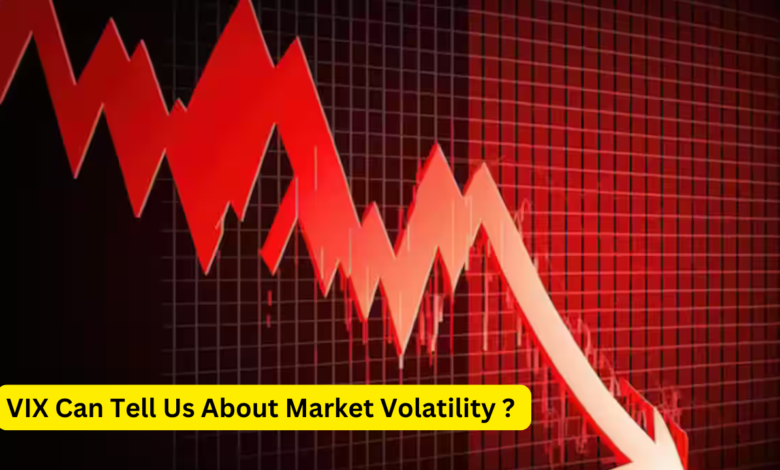VIX Can Tell Us About Market Volatility ?

Navigating the Current Financial Landscape: What the VIX Can Tell Us About Market Volatility, The stock market is a dynamic and often unpredictable environment, constantly influenced by global events, economic indicators, and investor sentiment. One tool that has become essential for understanding market volatility is the VIX—the Chicago Board Options Exchange (CBOE) Volatility Index. Often referred to as the “fear gauge,” the VIX measures the market’s expectations of future volatility based on S&P 500 index options. For investors, understanding the VIX is crucial for making informed decisions in both bullish and bearish markets.
What is the VIX?
The VIX is a real-time market index that represents the market’s expectations for volatility over the next 30 days. It is calculated based on the prices of options on the S&P 500 index, which are financial instruments that derive their value from the underlying stock index. A high VIX value indicates increased market uncertainty and potential volatility, while a low VIX value suggests a more stable and less volatile market.
The VIX is not just a tool for professional traders; it is also an essential resource for anyone looking to understand the broader market sentiment. During periods of economic uncertainty, geopolitical tensions, or major financial events, the VIX tends to spike, reflecting the heightened anxiety among investors. Conversely, when the market is calm and investor confidence is high, the VIX typically remains low.
Why the VIX Matters in Today’s Market
In recent months, the financial markets have experienced significant turbulence, with sharp declines in stock prices and increased volatility. This has led to a surge in the VIX, as investors grapple with the uncertainties surrounding global economic conditions, interest rate hikes, and geopolitical tensions.
Understanding the VIX can help investors anticipate market movements and adjust their portfolios accordingly. For instance, a rising VIX may signal that it is time to adopt a more defensive investment strategy, such as increasing allocations to bonds or other safer assets. On the other hand, a declining VIX might indicate that the market is stabilizing, presenting opportunities to invest in riskier assets.
How the VIX Influences Investment Strategies
The VIX is often used as a barometer for investor sentiment, and its movements can have a profound impact on various investment strategies. For example, in a high-VIX environment, investors may look to hedge their portfolios by purchasing options or other derivatives that benefit from increased volatility. This approach can help mitigate potential losses during periods of market turbulence.
Moreover, some traders specialize in trading the VIX itself, using it as a direct investment tool. This can involve trading VIX futures, options, or exchange-traded products (ETPs) that track the VIX. These strategies require a deep understanding of how the VIX functions and how it is likely to behave under different market conditions.
The VIX and Economic Indicators
The VIX is not only influenced by market sentiment but also by a wide range of economic indicators. For instance, inflation data, employment reports, and GDP growth figures can all impact the VIX. When economic data suggests that the economy is slowing down or that inflation is rising faster than expected, the VIX may increase as investors anticipate potential market disruptions.
Additionally, central bank policies, such as interest rate decisions, can also affect the VIX. For example, if the Federal Reserve signals that it plans to raise interest rates more aggressively, the VIX may rise as investors brace for potential market volatility. Conversely, dovish signals from the Fed—such as indicating a slower pace of rate hikes—could lead to a decrease in the VIX.
The Role of the VIX During Market Crashes
During significant market downturns, the VIX often experiences dramatic spikes. This was evident during the 2008 financial crisis, the 2020 COVID-19 pandemic, and other major market events. In such scenarios, the VIX can serve as an early warning system, alerting investors to the heightened risk of a market crash.
Investors who pay close attention to the VIX during these periods can take proactive measures to protect their portfolios. This might involve moving to cash, increasing exposure to safe-haven assets like gold, or employing hedging strategies to offset potential losses. The VIX‘s ability to signal impending market turbulence makes it an invaluable tool for both short-term traders and long-term investors.
The Future of the VIX: What Investors Should Watch
As we look to the future, the VIX is likely to remain a key indicator of market sentiment and volatility. With the global economy facing a range of challenges—including ongoing geopolitical tensions, inflationary pressures, and shifting central bank policies—investors should keep a close eye on the VIX as they navigate these uncertain times.
One potential development to watch is the impact of emerging technologies and new financial products on the VIX. For example, the rise of algorithmic trading and artificial intelligence could lead to more rapid and pronounced movements in the VIX, as these technologies react to market data in real-time. Additionally, the increasing popularity of VIX-linked investment products may influence how the index behaves in the future.
Conclusion: The VIX as a Tool for Navigating Market Volatility
In conclusion, the VIX is an essential tool for understanding and navigating market volatility. Whether you are a seasoned investor or just starting out, keeping an eye on the VIX can help you make more informed decisions and protect your portfolio during periods of uncertainty. As the financial landscape continues to evolve, the VIX will remain a critical barometer of market sentiment and an invaluable resource for investors worldwide.
What strategies do you use to manage your portfolio during periods of high market volatility? Share your thoughts in the comments below.





One Comment